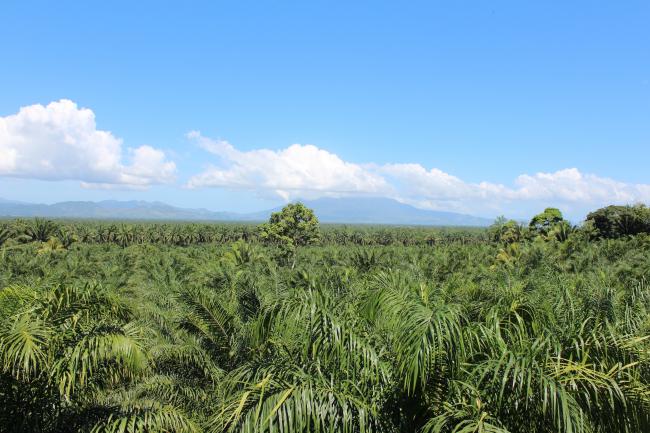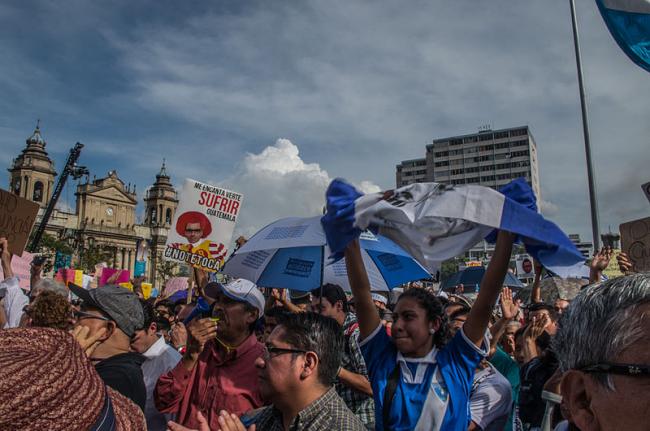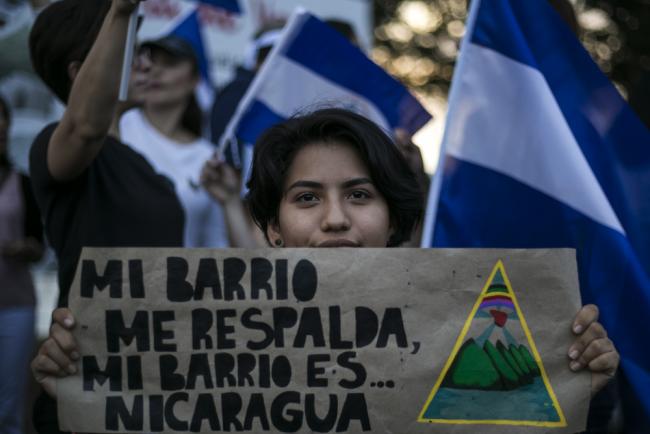
Some three decades after the wars of revolution and counterinsurgency came to an end in Central America, the region is once again on the brink of implosion. The Isthmus has been gripped by renewed mass struggle and state repression, the cracking of fragile political systems, unprecedented corruption, drug violence, and the displacement and forced migration of millions of workers and peasants. The backdrop to this second implosion of Central America, reflecting the spiraling crisis of global capitalism itself, is the exhaustion of a new round of capitalist development in recent years to the same drumbeat as the globalization that took place in the wake of the 1980s upheavals.
Lost in the headlines on Central American refugees fleeing to the United States is both the historical context that has sparked the exodus and the structural transformations through capitalist globalization that has brought the region to where it is today. The mass revolutionary movements of the 1970s and 1980s did manage to dislodge entrenched military-civilian dictatorships and open up political systems to electoral competition, but they were unable to achieve any substantial social justice or democratization of the socioeconomic order.
Capitalist globalization in the Isthmus in the wake of pacification unleashed a new cycle of modernization and accumulation. It transformed the old oligarchic class structures, generated new transnationally oriented elites and capitalists and high-consumption middle classes even as it displaced millions, aggravated poverty, inequality, and social exclusion, and wreaked havoc on the environment, triggering waves of outmigration and new rounds of mass mobilization among those who stayed behind. Hence the very conditions that gave rise to the conflict in the first place were aggravated by capitalist globalization.
Despite the illusion of “peace and democracy” so touted by the transnational elite in the wake of pacification, the roots of the regional conflict have persisted: the extreme concentration of wealth and political power in the hands of elite minorities alongside the pauperization and powerlessness of a dispossessed majority. With the 2009 coup d’état in Honduras, the massacre of peaceful protesters in Nicaragua in 2018, and the return of death squads in Guatemala, this illusion has been definitively shattered.
The Transnational Model of Capitalist Development
As Central America became swept up into globalization from the 1990s, a new breed of transnationally-oriented capitalists and state elites forged a neoliberal hegemony in consort with Washington and the international financial institutions (IFIs, principally the US Agency for International Development, the IMF, and the World Bank). They imposed privatization, austerity, deregulation of labor markets, new investment regimes to facilitate transnational corporate access to the region’s abundant natural resources and fertile lands, and free trade deals including the Central American Free Trade Agreement in 2004.
The transnational model of accumulation involved the introduction of new economic activities that integrated the region into transnational production and service chains, part of the capitalist globalization that has involved a vast expansion of mining operations, agribusiness, tourism, energy extraction, and infrastructure mega-projects throughout Latin America, feeding a voracious global economy and swelling transnational corporate coffers. Like earlier cycles of capitalist development, an expansion of exports and a deeper integration into the world economy resulted in a reactivation of growth and investment in the 1990s and on.
The evolution of Central America’s political economy closely mirrors that of the global economy as a whole. The world economy went through a period of prosperity in the 1960s, then crisis and stagnation in the 1970s and 1980s, followed by the globalization boom of the 1990s and the first decade of the 21st century. Closely mirroring this evolution, the Isthmus experienced an average annual growth rate of 5.7 percent from 1960-1970, which declined to 3.9 percent from 1970-1980 and then plummeted to just 0.8 percent in the tumultuous 1980-1990 decade. But then, in sync with the global economy, growth recovered, averaging 4.0 percent annually during the globalization boom of 1990-2008. In the wake of the financial collapse of 2008, Central American growth rates began to decline again.
Globalization as a qualitatively new phase in the ongoing and open-ended evolution of world capitalism has been characterized above all by the rise of a globally integrated production, financial, and service system. In Central America, the transnational model of accumulation that took hold during the boom has involved a vast expansion of maquiladoras producing garments, electronics, and other industrial goods, agro-industrial complexes, mining and raw material extraction, global banking, tourism, and the “retail revolution,” or the spread of Walmart and other super-stores, as I’ve written in my book.
Export processing zones (EPZs), meanwhile, set up since the late 1980s, dot the Central American urban landscape. Some 70 EPZs now employ some 800,000 workers, mostly young women, and have inserted the region inextricably into the Global Factory.
At the same time, the spread of transnational tourist complexes has turned Central America into a global playground. Local Indigenous, Afro-descendant, and mestizo communities have fought displacement, environmental degradation, and the commodification of local cultures by tourist mega-projects such as the Ruta Maya throughout the region, Roatan in Honduras, San Juan del Sur in Nicaragua, Costa del Sol in El Salvador, or Guanacaste province in Costa Rica. Services, commerce, and finance have also become transnationalized. The arrival of the global supermarket has involved the invasion of transnational retail conglomerates such as Walmart and fast food chains, which have displaced thousands of small traders, disrupted local economies, and propagated a global consumer culture and ideology.

Globalization also brought with it a major expansion of transnational agribusiness. In Honduras, local and transnational capitalist interests have snatched up vast tracks of rural farmland from peasant, Afro-descendant, and Indigenous communities and converted them into palm oil plantations. In Guatemala, too, palm oil planted by local suppliers of global agro-industrial giants ADM and Cargill is uprooting a growing number of peasant communities and driving them to migrate abroad. In Nicaragua, peasants displaced by transnational agribusiness have pushed into and colonized what remained of the agricultural frontier, disrupting Indigenous land. Costa Rica is now a major exporter of exotic new products such as figs, dates, and winter fruits and vegetables produced by transnational agribusiness that has displaced peasant producers and pushed them further into the agricultural frontier.
Most devastating to the ecology and livelihood of local communities is a new round of extractive activity, including mining, oil, and gas, along with fishing and forestry, not to mention the mega infrastructural projects such as an interoceanic canal in Nicaragua and the Agua Zarca dam in Honduras. Conflict has shaken the Indigenous highlands in Guatemala anew, as local communities fight a veritable invasion by gold, silver, and other metal mining and fossil fuel interests — in some cases even facing off death squads — and a renewed colonization of their territory by agribusiness.
Anti-mining activists have faced death threats and assassinations in El Salvador, where 90 percent of surface water is estimated to be polluted by toxic chemicals, heavy metals, and waste matter as a result of mining. These activists won a historic victory in 2017 when the government passed legislation imposing a blanket ban on metal mining. Environmental and community activists fighting the government’s concessions to transnational companies for large-scale gold mining projects in Nicaragua have faced down riot police, as have activists in neighboring Costa Rica protesting gold mining concessions in the north of the country.
The Façade Cracks: Economic Stagnation, Political Upheaval and Social Collapse
The tenuous social order globalization brought about could only be sustained so long as the economy expanded and those displaced managed to migrate North. Yet the resumption of growth since the 1990s has depended on three factors that are now reaching their limits: a sharp rise in the inflow of transnational corporate investment, a steady increase in external debt, and remittances from Central Americans living abroad.
After a decade of capital flight and disinvestment in the 1980s, Central America again became an attractive investment site for transnational capital in the 1990s. Transnational corporate investment jumped from an annual average of $165 million in the 1990s to $631 million from 2000 to 2010, and then to $6.5 billion from 2011 to 2017 (although Costa Rica accounted for 45 percent of this surge), as surplus capital from North America and Asia sought new investment opportunities abroad following the 2008 global financial collapse. However, disaggregating the latter figure, foreign direct investment actually dropped sharply starting in 2016, to just above $1 billion annually. Along with this inflow of investment capital, the Central American economy has accrued rising levels of foreign debt, jumping from $33 billion in 2005 to $79 billion in 2018 which, at nearly half the region’s combined GDP, is unsustainable.
But above all, the $20 billion in remittances Central American migrants have sent back home has provided an economic lifeline to the regional economy, while outmigration has acted an escape valve containing political crises. Eighteen and 19 percent of El Salvador and Honduras’ GNP, respectively, comes from remittances, and 10% of Guatemala and Nicaragua’s. In fact, remittances accounted for half of all growth in the GDP in these four countries in 2017, and 78 percent for El Salvador. In other words, the region’s economy would collapse without the money Central Americans send home.
Yet the benefits of growth since the 1990s never trickled down to the impoverished majority, with the exception of an expansion of social programs in Nicaragua during the first few years of Daniel Ortega’s return to power in 2007, and a few programs that the FMLN government in El Salvador was able to introduce. Now, however, as the global economy sputters toward recession and investment flows decline, there are diminishing opportunities for capitalist expansion in the Isthmus. From the average annual growth rate of four percent from 1990-2008, the regional GDP growth rate dropped to 3.7 percent in 2012, to 3.5 percent in 2017, and an estimated 2.6 percent in 2018.
Globalization and neoliberalism have wreaked havoc on the working and popular classes, leaving them ill-equipped to survive the coming global economic downturn and local stagnation. A staggering 72 percent of workers in the region labor in precarious work arrangements, often in the informal economy, and some seven out of every eight new jobs are precarious. The Central American population has increased from 25 million in 1990 to over 40 million in 2017 but the labor market has been unable to absorb the majority of new entrants, which helps explain the surge in migration abroad, a number that practically doubled from 2000 to 2017, when it reached 4.3 million.
The social crisis is now leading to escalating political conflict and an unprecedented spiral of corruption. Corrupt state elites backed by national private sector associations, the transnational capitalist class, and IFIs have imposed the globalization model. These same elites facilitated the conditions for local and transnational capital to appropriate the region’s resources and labor in exchange for the opportunity to pillage the state. The long list of corruption cases in the region has landed several former presidents in jail and brought charges against dozens of high-level government officials.

In Guatemala, former president Otto Pérez Molina, a retired military officer during a genocide against the country’s Indigenous majority in the 1980s counterinsurgency, was forced to step down in 2015 after mass protests against his government’s widespread corruption, uncovered by the United Nations International Commission against Impunity in Guatemala (CICIG), formed in 2006 to investigate corruption, drug trafficking, and genocide. Pérez Molina was eventually tried and sentenced to prison. Current president Jimmy Morales, elected after Pérez Molina’s resignation, has dismantled the CICIG, since it brought fraud and money laundering charges against him, his family members, and other high-level officials.
The larger backdrop to political instability in Guatemala is an upsurge of mass mobilization among the country’s poor and largely Indigenous majority and the return of widespread repression and human rights violations, including the reappearance of death squads that terrorized the population for decades prior to the 1996 peace accord that put an end to the four-decade civil war. The CODECA (Campesino Development Committee), the Campesino Committee of the Highlands (CCDA), and other Indigenous, peasant, student, and worker organizations have organized mass resistance around the country, and are calling for a Constituent National Assembly to re-found the republic and develop “an alternative to capitalism.”
In Honduras, several members of the ruling National Party and family members of former president Porfirio Lobo, brought to power by the 2009 coup d’état, and current president, Juan Orlando Hernández, elected for a second term in 2017 in a contest widely believed to be fraudulent, have been implicated in drug trafficking, embezzlement, and other crimes. While the murder of Indigenous leader Berta Cáceres in 2016 grabbed international headlines, dozens of leaders from the country’s burgeoning social movements of Indigenous, students, workers, peasants, and Afro-descendants have been targeted for assassination.
In El Salvador, the courts convicted former president Antonio Saca to 10 years in prison and issued an arrest warrant for former president Mauricio Funes, who took refuge in Nicaragua after being charged with embezzlement. The Attorney General’s office is investigating other high-level officials for corruption, including those from the governing Farabundo Marti National Liberation Front (FMLN), which is likely to be voted out of power in elections this February. In Nicaragua, the nepotistic and dictatorial government of president Daniel Ortega, his wife, vice-president Rosario Murillo, and their inner circle, have made pacts with the traditional oligarchy, enriched themselves through plunder of state resources and an alliance with transnational capital, and deployed the army, police, and paramilitary forces to violently repress peasants, workers, students, and social movements opposing its policies.

The Crisis of Global Capitalism and the Future of Central America
Global capitalism now faces a deep structural crisis of social polarization and overaccumulation. Given unprecedented levels of inequality worldwide, the global market cannot absorb the rising output of the global economy, which is reaching limits to further expansion. The transnational capitalist class cannot find outlets to profitably reinvest the trillions of dollars in accumulated profits. Continued expansion in recent years has been based on unsustainable debt-driven consumption, wild speculation in the global casino that has inflated one financial bubble after another, and state-driven militarization as the world enters a global war economy.
Now the global economy is on the brink of a new downturn. Moreover, the system faces a political crisis of hegemony and escalating international tensions. In the larger picture, this crisis of global capitalism forms the backdrop to the second implosion of Central America.
The crisis has resulted in sharp polarization worldwide between insurgent left and popular forces and an insurgent far-right, with openly fascist tendencies at its fringes. As the regimes in Central America lose legitimacy, become more corrupt and repressive, and threaten to break with the constitutional order, as already happened in Honduras and Nicaragua and may happen in Guatemala, a new round of mass popular protest unfolds. In response, the region’s governments have also turned to bogus anti-terrorism laws to keep a lid on social protest.
Far-right and 21st-century fascist projects are on the rise in Europe, the United States, Brazil, Israel, the Philippines, Turkey, and elsewhere. In all these cases, the most vulnerable communities have been targeted as scapegoats for the crisis, especially refugees and immigrants, in a strategy to channel mass anxiety over escalating socioeconomic insecurity towards the targeted groups. This helps explain the rabidly racist and even fascist response of the Trump government to Central American refugees. Neither fascism nor implosion are inevitable. That will depend on how the popular forces in Central and North America are able to mobilize to preserve the rule of law and push forward a social justice agenda that could ameliorate the effects of crisis. Otherwise, an economic downturn could bring down the Central American house of cards.
Join us in defending the truth before it’s too late
The future of independent journalism is uncertain, and the consequences of losing it are too grave to ignore. To ensure Truthout remains safe, strong, and free, we need to raise $27,000 in the next 24 hours. Every dollar raised goes directly toward the costs of producing news you can trust.
Please give what you can — because by supporting us with a tax-deductible donation, you’re not just preserving a source of news, you’re helping to safeguard what’s left of our democracy.